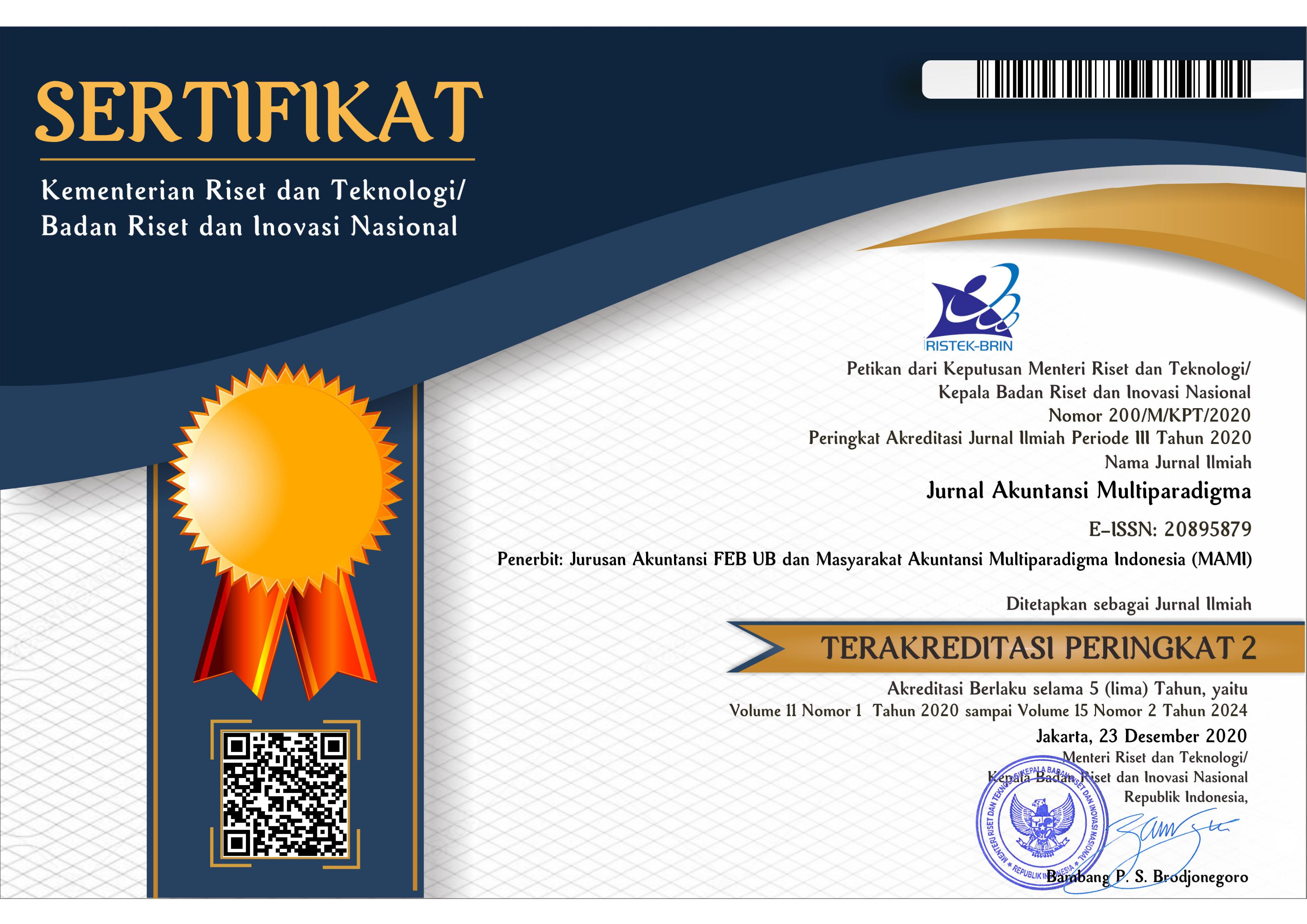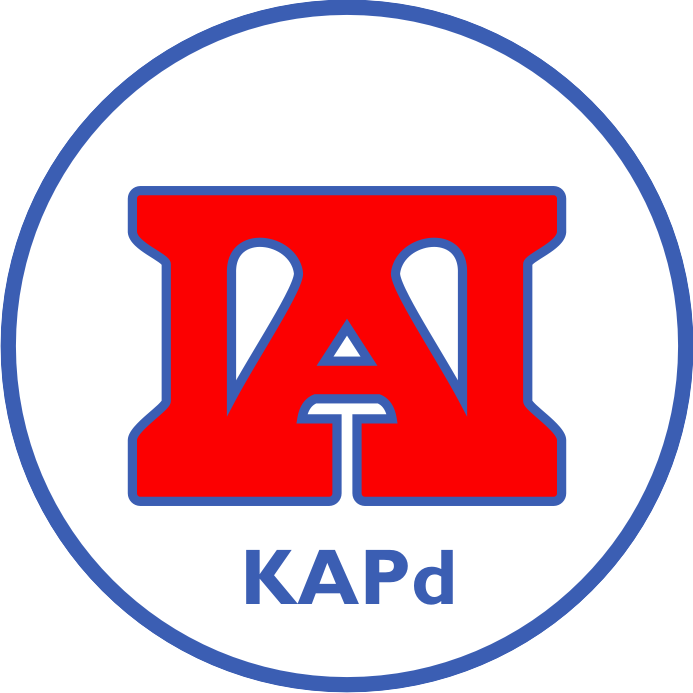REORENTASI AUDIT INTERNAL UNTUK MELAWAN KORUPSI PENGADAAN
Abstract
Abstrak: Reorientasi Audit Internal untuk Melawan Korupsi Pengadaan. Tujuan penelitian ini adalah untuk menemukan reorientasi peran audit internal dalam melawan korupsi pengadaan. Penelitian ini menggunakan metode configurative-ideographic case study pada informan yang berasal dari Auditor Pengawas Internal Pemerintah (APIP). Penelitian ini menemukan bahwa informan sering jatuh pada sikap penilaian profesional yang tidak objektif pada kegiatan pengadaan yang di dalamnya terdapat political corruption. Peneliti mengusulkan struktur pengawasan internal pemerintah daerah dengan pendekatan three lines for defense. Konsep ini mendedikasikan artikulasi yang jelas terhadap peran audit internal di lingkungan pemerintah daerah dalam memberikan support assurance.
Abstract: Internal Audit Reorientation Against Procurement Corruption. The purpose of this study is to find a reorientation of the role of internal audit in the fight against procurement corruption. This study uses configurative-ideographic case study method on informants from the government's internal auditor. This study finds that informants often fall into the attitude of professional judgment that is not objective in procurement activities, in which there is political corruption. The researcher proposes the internal supervision structure of the regional government using the three lines for the defense approach. This concept dedicates a clear articulation of internal audit’s roles within the local government environment in providing support assurance.
Keywords
Full Text:
PDFReferences
Abdullatif, M., & Kawuq, S. (2015). The Role of Internal Auditing in Risk Management: Evidence from Banks in Jordan. Journal of Economic and Administrative Sciences, 31(1), 30-50. https://doi.org/10.1108/JEAS-08-2013-0025
Abidin, N. H. Z. (2017). Factors Influencing the Implementation of Risk-Based Auditing. Asian Review of Accounting, 25(3), 361-375. https://doi.org/10.1108/ARA-10-2016-0118
Aghghaleh, S. F., Mohamed, Z M., & Ahmad, A. (2014), The Effects of Personal and Organizational Factors on Role Ambiguity amongst Internal Auditors. International Journal of Auditing, 18(2), 105-114. https://doi.org/10.1111/ijau.12015
Aikins, S. K. (2013). Government Internal Audits: The Determinants of Quality Supervisory Review of Audit Documentation. International Journal of Public Administration, 36(10), 673-685. https://doi.org/10.1080/01900692.2013.791309
Akbar, Y. H., & Vujić, V. (2014). Explaining Corruption: The Role of National Culture and Its Implications for International Management. Cross Cultural Management: An International Journal, 21(2), 191-218. https://doi.org/10.1108/CCM-03-2013-0050
Asiedu, K. F., & Deffor, E. W. (2017). Fighting Corruption by Means of Effective Internal Audit Function: Evidence from the Ghanaian Public Sector. International Journal of Auditing, 21(1), 82– 99. https://doi.org/10.1111/ijau.12082.
Alqudah, H. M., Amran, N. A., & Hassan, H. (2019). Factors Affecting the Internal Auditors’ Effectiveness in the Jordanian Public Sector: The Moderating Effect of Task Complexity. EuroMed Journal of Business, 14(3), 251-273. https://doi.org/10.1108/EMJB-03-2019-0049
Altamuro, J. M., & Beatty, A. (2010). How Does Internal Control Regulation Affect Financial Reporting ? Journal of Accounting and Economics, 49(1), 58–74. https://doi.org/10.1016/j.jacceco.2009.07.002
Barr-Pulliam, D. (2019). The Effect of Continuous Auditing and Role Duality on the Incidence and Likelihood of Reporting Management Opportunism. Management Accounting Research, 44, 44-56. https://doi.org/10.1016/j.mar.2018.10.001
Barišić, I., & Tušek, B. (2016). The Importance of the Supportive Control Environment for Internal Audit Effectiveness – The Case of Croatian Companies. Economic Research, 29(1), 1021-1037. https://doi.org/10.1080/1331677X.2016.1211954
Batzilis, D. (2019). Electoral Competition and Corruption: Evidence from Municipality Audits in Greece. International Review of Law and Economics, 59, 13-20. https://doi.org/10.1016/j.irle.2019.04.003
Baxter, R., Bedard, J. C., Hoitash, R., & Yezegel, A. (2013). Enterprise Risk Management Program Quality: Determinants, Value Relevance, and the Financial Crisis. Contemporary Accounting Research, 30(4), 1264-1295. https://doi.org/10.1111/j.1911-3846.2012.01194.x
Behrend, J., & Eulerich, M. (2019). The Evolution of Internal Audit Research: A Bibliometric Analysis of Published Documents (1926-2016). Accounting History Review, 29(1), 103-139. https://doi.org/10.1080/21552851.2019.1606721
Bell, T. B., Causholli, M., & Knechel, W. R. (2015), Audit Firm Tenure, Non‐Audit Services, and Internal Assessments of Audit Quality. Journal of Accounting Research, 53(3), 461-509. https://doi.org/10.1111/1475-679X.12078
Bengtsson, B., & Hertting, N. (2014). Generalization by Mechanism: Thin Rationality and Ideal-type Analysis in Case Study Research. Philosophy of the Social Sciences, 44(6), 707–732. https://doi.org/10.1177/0048393113506495
Bradbury, M. E., & Redmayne, N. B. (2014). Audit Effort and Pricing Differences among the Large Audit Firms: Evidence from a Public Sector Setting. International Journal of Auditing, 18(1), 90-100. https://doi.org/10.1111/ijau.12014
Brucker, W. G., & Rebele, J. E. (2010). Fraud at a Public Authority. Journal of Accounting Education, 28(1), 26–37. https://doi.org/10.1016/j.jaccedu.2010.10.001
Butt, S. (2011). Reform in Indonesia: An Obituary? Bulletin of Indonesian Economic Studies, 47(3), 381-394. https://doi.org/10.1080/00074918.2011.619051
Chambers, A. D. (2014a). New Guidance on Internal Audit – An Analysis and Appraisal of Recent Developments. Managerial Auditing Journal, 29, 196–218. https://doi.org/10.1108/MAJ-08-2013-0925
Chambers, A. D. (2014b). The Current State of Internal Auditing: A Personal Perspective and Assessment. EDPACS: The EDP Audit, Control, and Security Newsletter, 49(1), 1-14. https://doi.org/10.1080/07366981.2014.869962
Chen, J., Chan, K. C., Dong, W., & Zhang, F. F. (2017). Internal Control and Stock Price Crash Risk: Evidence from China. European Accounting Review, 26(1), 125-152. https://doi.org/10.1080/09638180.2015.1117008
Chiara, A. D., & Livio, L. (2017). The Threat of Corruption and the Optimal Supervisory Task. Journal of Economic Behavior & Organization, 133, 172-186. https://doi.org/10.1016/j.jebo.2016.11.006
Christopher, J. (2015). Internal Audit: Does It Enhance Governance in the Australian Public University Sector? Educational Management Administration & Leadership, 43(6), 954–971. https://doi.org/10.1177/1741143214543206
Coetzee, P., & Erasmus, L. J. (2017). What Drives and Measures Public Sector Internal Audit Effectiveness? Dependent and Independent Variables. International Journal of Auditing, 21(3), 237-248. https://doi.org/10.1111/ijau.12097
COSO. (2013). The 2013 COSO Framework & SOX Compliance: One Approach to an Effective Transition. Tersedia pada: https://www.coso.org/documents/COSO%20McNallyTransition%20Article-Final%20COSO%20Version%20Proof_5-31-13.pdf (Diakses: 22 Juli 2019).
Davies, H., & Zhivitskaya, M. (2018). Three Lines of Defence: A Robust Organising Framework, or Just Lines in the Sand? Global Policy, 9(S1). 34-42. https://doi.org/10.1111/1758-5899.12568
Detkova, P., Podkolzina, E., & Tkachenko, A. (2018). Corruption, Centralization and Competition: Evidence from Russian Public Procurement. International Journal of Public Administration, 41(5-6), 414-434. https://doi.org/10.1080/01900692.2018.1426014
Ege, M. S. (2015). Does Internal Audit Function Quality Deter Management Misconduct? The Accounting Review, 90(2), 495-527. https://doi.org/10.2308/accr-50871
Elbardan, H., Ali, M., & Ghoneim, A. (2016). Enterprise Resource Planning Systems Introduction and Internal Auditing Legitimacy: An Institutional Analysis. Information Systems Management, 33(3), 231-247. https://doi.org/10.1080/10580530.2016.1188545
Elman, C., Gerring, J., & Mahoney, J. (2016). Case Study Research: Putting the Quant Into the Qual. Sociological Methods & Research, 45(3), 375–391. https://doi.org/10.1177/0049124116644273
Endaya, K., & Hanefah, M. (2016). Internal Auditor Characteristics, Internal Audit Effectiveness, and Moderating Effect of Senior Management. Journal of Economic and Administrative Sciences, 32(2), 160-176. https://doi.org/10.1108/JEAS-07-2015-0023
Farkas, M., Hirsch, R., & Kokina, J. (2019). Internal Auditor Communications: An Experimental Investigation of Managerial Perceptions. Managerial Auditing Journal, 34(4), 462-485. https://doi.org/10.1108/MAJ-06-2018-1910
Feng, M., Li, C., McVay, S. E., & Skaife, H. (2015). Does Ineffective Internal Control over Financial Reporting Affect a Firm’s Operations? Evidence from Firms’ Inventory Management. The Accounting Review, 90(2), 529–557. https://doi.org/10.2308/accr-50909
Ferry, L., Zakaria, Z., Zakaria, Z., & Slack, R. (2017a). Watchdogs, Helpers or Protectors ? Internal Auditing in Malaysian Local Government. Accounting Forum, 41(4), 375-389. https://doi.org/10.1016/j.accfor.2017.10.001
Funaki, Y., & Glencorse, B. (2014). Anti-Corruption or Accountability? International Efforts in Post-Conflict Liberia, Third World Quarterly, 35(5), 836-854. https://doi.org/10.1080/01436597.2014.921433
Gamar, N., & Djamhuri, A. (2015). Auditor Internal sebagai “Dokter” Fraud di Pemerintah Daerah. Jurnal Akuntansi Multiparadigma, 6(1), 107–123. https://doi.org/10.18202/jamal.2015.04.6009
Gerring, J., & Cojocaru, L. (2016). Selecting Cases for Intensive Analysis: A Diversity of Goals and Methods. Sociological Methods & Research, 45(3), 392–423. https://doi.org/10.1177/0049124116631692
Gong, T., & Zhou, N. (2015), Corruption and Marketization: Formal and Informal Rules in Chinese Public Procurement. Regulation & Governance, 9(1), 63-76. https://doi.org/10.1111/rego.12054
Grace, E. V., & Davis, A. (2019). Who's in Control of the Ark? A Study of Internal Controls in Operating and Auditing A Small Preschool. Issues in Accounting Education, 34(2), 23-39. https://doi.org/10.2308/iace-52375
Gustavson, M., & Sundström, A. (2018). Organizing the Audit Society: Does Good Auditing Generate Less Public Sector Corruption? Administration & Society, 50(10), 1508–1532. https://doi.org/10.1177/0095399716674306
Haapamäki, E., & Sihvonen, J. (2019). Research on International Standards on Auditing: Literature Synthesis and Opportunities for Future Research. Journal of International Accounting, Auditing and Taxation, 35, 37-56. https://doi.org/10.1016/j.intaccaudtax.2019.05.007
Halbouni, S., Obeid, N., & Garbou, A. (2016). Corporate Governance and Information Technology in Fraud Prevention and Detection: Evidence from the UAE. Managerial Auditing Journal, 31(6), 589-628. https://doi.org/10.1108/MAJ-02-2015-1163
Harun, Van-Peursem, K. V., & Eggleton, I. R. C. (2015). Indonesian Public Sector Accounting Reforms: Dialogic Aspirations a Step Too Far? Accounting, Auditing & Accountability Journal, 28(5), 706-738. https://doi.org/10.1108/AAAJ-12-2012-1182
Hazami‐Ammar, S. (2019). Some Evidence on the Impact of Internal Audit on External Audit Fees. The Journal of Corporate Accounting and Finance, 30(2), 64-81. https://doi.org/10.1002/jcaf.22384
He, K., Pan, X., & Tian, G. (2017). Legal Liability, Government Intervention, and Auditor Behavior: Evidence from Structural Reform of Audit Firms in China. European Accounting Review, 26(1), 61-95. https://doi.org/10.1080/09638180.2015.1100547
Hellman, J. (2017). Democracy, Corruption and the Politics of Spirits in Contemporary Indonesia. The Asia Pacific Journal of Anthropology, 18(1), 91-93. https://doi.org/10.1080/14442213.2016.1162124
Hoos, F., Messier, W. F., Smith, J. L., & Tandy, P. R. (2018). An Experimental Investigation of the Interaction Effect of Management Training Ground and Reporting Lines on Internal Auditors’ Objectivity. International Journal of Auditing, 22(2), 150-163. https://doi.org/10.1111/ijau.12110
IIA. (2013). The Three Lines of Defense in Effective Risk Management and Control. Tersedia pada: https://na.theiia.org/standards-guidance/Public%20Documents/PP%20The%20Three%20Lines%20of%20Defense%20in%20Effective%20Risk%20Management%20and%20Control.pdf (Diakses: 21 Juli 2019).
IIA. (2015). Governance of Risk : Three Lines of Defence. Tersedia pada: https://www.iia.org.uk/resources/audit-committees/governance-of-risk-three-lines-of-defence/ (Diakses: 21 Juli 2019).
IIA. (2018). Internal Auditing's Role in Corporate Governance. Tersedia pada: https://na.theiia.org/about-ia/PublicDocuments/Internal-Auditings-Role-in-Corporate-Governance.pdf (Diakses: 21 Juli 2019).
Jain, A. K. (2017). Fighting Corruption: Contemporary Measures in Canada. Canadian Foreign Policy Journal, 23(1), 93-116. https://doi.org/10.1080/11926422.2016.1270846
Jamaluddin, & Syarifuddin. (2015). Ambiguitas dan Konflik Peran serta Independensi sebagai Determinan Kualitas Audit Internal. Jurnal Akuntansi Multiparadigma, 5(3), 421-431. https://doi.org/10.18202/jamal.2014.12.5031
Kamayanti, A. (2016). Metodologi Penelitan Kualitatif Akuntansi: Pengantar Religiositas Keilmuan. Jakarta: Yayasan Rumah Peneleh.
Kral, R. (2018). Integrating a Compliance and Ethics Program with a Control Framework Leveraging COSO’S Internal Control–Integrated Framework. EDPACS: The EDP Audit, Control, and Security Newsletter, 57(6), 11-17. https://doi.org/10.1080/07366981.2018.1444010
Li, H., Tang, M., & Huhe, N. (2016). How does Democracy Influence Citizens’ Perceptions of Government Corruption? A Cross-National Study. Democratization, 23(5), 892-918. https://doi.org/10.1080/13510347.2015.1039995
Lin, Y. H., Cefaratti, M. A., Lee, C. C., & Huang, H. W. (2018). Internal Control Material Weaknesses and Foreign Corrupt Practices Act Violations. Journal of Forensic Accounting Research, 3(1), 80-104. https://doi.org/10.2308/jfar-52296
Lisic, L. L., Neal, T. L., Zhang, I. X., & Zhang, Y. (2016). CEO Power, Internal Control Quality, and Audit Committee Effectiveness in Substance Versus in Form. Contemporary Accounting Research, 33(3), 1199-1237. https://doi.org/10.1111/1911-3846.12177
Liston-Heyes, C., & Juillet, L. (2019). Employee Isolation and Support for Change in the Public Sector: A Study of the Internal Audit Profession. Public Management Review, 21(3), 423-445. https://doi.org/10.1080/14719037.2018.1500628
Luburić, R. (2017). Strengthening the Three Lines of Defence in Terms of More Efficient Operational Risk Management in Central Banks, Journal of Central Banking Theory and Practice, 6(1), 29-53. doi: https://doi.org/10.1515/jcbtp-2017-0003
Mabwe, K., Ring, P. J., & Webb, R. (2017). Operational Risk and the Three Lines of Defence in UK Financial Institutions: Is Three Really the Magic Number? The Journal of Operational Risk, 12(1), 53-69. https://doi.org/10.21314/jop.2017.187
Morales, J., Gendron, Y., & Guénin-Paracini, H. (2014). The Construction of the Risky Individual and Vigilant Organization: A Genealogy of the Fraud Triangle. Accounting, Organizations and Society, 39(3), 170-194. https://doi.org/10.1016/j.aos.2014.01.006
Motubatse, K. N., Staden, M. V., Steyn, B., & Erasmus, L. (2015). Audit Tools and Techniques: Crucial Dimensions of Internal Audit Engagements in South Africa. Journal of Economics, 6(3), 269-279. https://doi.org/10.1080/09765239.2015.11917616
Muhsin. (2018). Peran Tekanan Anggaran Waktu Auditor dalam Memoderasi Effort dan Kinerja Audit Judgment. Jurnal Akuntansi Multiparadigma, 9(2), 223-235. https://doi.org/10.18202/jamal.2018.04.9013
Nesti, L. (2014). The 2010 “Agreement on Mutual Enforcement of Debarment Decisions” and Its Impact for the Fight Against Fraud and Corruption in Public Procurement. Journal of Public Procurement, 14(1), 62-95. https://doi.org/10.1108/JOPP-14-01-2014-B003
Neu, D., Everett, J., & Rahaman, A. S. (2013). Internal Auditing and Corruption within Government: The Case of the Canadian Sponsorship Program. Contemporary Accounting Research, 30(3), 1223–1250. https://doi.org/10.1111/j.1911-3846.2012.01195.x
Neu, D., Everett, J., & Rahaman, A. S. (2015). Preventing Corruption within Government Procurement: Constructing the Disciplined and Ethical Subject. Critical Perspectives on Accounting, 28, 49-61. https://doi.org/10.1016/j.cpa.2014.03.012
Novriansa, A., & Riyanto, B. (2016). Role Conflict and Role Ambiguity on Local Government Internal Auditors: The Determinant and Impacts. Journal of Indonesian Economy and Business, 31(1), 63–82. https://doi.org/10.22146/jieb.10320
Pilcher, R., Gilchrist, D., Singh, H., & Singh, I. (2013). The Interface between Internal and External Audit in the Australian Public Sector. Australian Accounting Review, 23(4), 330-340. https;//doi.org/10.1111/auar.12032
Prabowo, H. Y. (2014). To be Corrupt or Not to be Corrupt: Understanding the Behavioral Side of Corruption in Indonesia. Journal of Money Laundering Control, 17(3), 306-326. https://doi.org/10.1108/JMLC-11-2013-0045
Premuroso, R., & Houmes, R. (2012). Financial Statement Risk Assessment Following the COSO Framework: An Instructional Case Study. International Journal of Accounting & Information Management, 20(1), 26-48. https://doi.org/10.1108/18347641211201063
Rae, K., Sands, J., & Subramaniam, N. (2017). Associations among the Five Components within COSO Internal Control-Integrated Framework as the Underpinning of Quality Corporate Governance. Australasian Accounting, Business and Finance Journal, 11(1), 28-54. https://doi.org/10.14453/aabfj.v11i1.4
Rahayu, F. S., & Fidiana. (2018). Derterminan Kualitas Opini Audit Pemerintah Daerah. Jurnal Akuntansi Multiparadigma, 9(2), 267-279. https://doi.org/10.18202/jamal.2018.04.9016
Rendon, J., & Rendon, R. (2016). Procurement Fraud in the US Department of Defense: Implications for Contracting Processes and Internal Controls. Managerial Auditing Journal, 31(6), 748-767. https://doi.org/10.1108/MAJ-11-2015-1267
Rose, A. M., Rose, J. M., & Norman, C. S. (2013). Is the Objectivity of Internal Audit Compromised when the Internal Audit Function is a Management Training Ground? Accounting & Finance, 53(4), 1001-1019. https://doi.org/10.1111/acfi.12025
Rotberg, R. I. (2017). Canada’s Corruption at Home and Abroad: An Introduction to the Special Issue. Canadian Foreign Policy Journal, 23(1), 1-14. https://doi.org/10.1080/11926422.2016.1254664
Roussy, M. (2013). Internal Auditors ’ Roles : From Watchdogs to Helpers and Protectors of the Top Manager. Critical Perspectives on Accounting, 24(7), 550–571. https://doi.org/10.1016/j.cpa.2013.08.004
Saint-Georges, I. D. (2018). Generalizing from Case Studies: A Commentary. Integrative Psychological and Behavioral Science, 52, 94-103. https://doi.org/10.1007/s12124-017-9402-x
Setiawan, A. R., Irianto, G., & Achsin, M. (2013). System-Driven (Un) Fraud: Tafsir Aparatur terhadap “Sisi Gelap” Pengelolaan Keuangan Daerah. Jurnal Akuntansi Multiparadigma, 4(1), 85-100. https://doi.org/10.18202/jamal.2013.04.7184
Sharma, S. K., Sengupta, A., & Panja, S. C. (2019). Mapping Corruption Risks in Public Procurement: Uncovering Improvement Opportunities and Strengthening Controls. Public Performance & Management Review, 42(4), 947-975. https://doi.org/10.1080/15309576.2018.1535984
Sikka, P., & Lehman, G. (2015). The Supply-Side of Corruption and Limits to Preventing Corruption within Government Procurement and Constructing Ethical Subjects. Critical Perspectives on Accounting, 28, 62-70. https://doi.org/10.1016/j.cpa.2015.01.008
Singh, A. S. (2014). Conducting Case Study Research in Non-Profit Organisations. Qualitative Market Research, 17(1), 77-84. https://doi.org/10.1108/QMR-04-2013-0024
Suh, J. B., Nicolaides, R., & Trafford, R. (2019). The Effects of Reducing Opportunity and Fraud Risk Factors on the Occurrence of Occupational Fraud in Financial Institutions. International Journal of Law, Crime and Justice, 56, 79-88. https://doi.org/10.1016/j.ijlcj.2019.01.002
Thomas, G. (2011). A Typology for the Case Study in Social Science Following a Review of Definition, Discourse, and Structure. Qualitative Inquiry, 17(6), 511–521. https://doi.org/10.1177/1077800411409884
Utami, I., Wijono, S., Noviyanti, S., & Mohamed, N. (2019). Fraud Diamond, Machiavellianism and Fraud Intention. International Journal of Ethics and Systems, 35(4), 531-544. https://doi.org/10.1108/IJOES-02-2019-0042
Wang, I. Z., & Fargher, N. (2017). The Effects of Tone at the Top and Coordination with External Auditors on Internal Auditors’ Fraud Risk Assessments. Accounting & Finance, 57(4), 1177-1202. https://doi.org/10.1111/acfi.12191
Zakaria, K. M., Nawawi, A., & Salin, A. S. A. P. (2016). Internal Controls and Fraud – Empirical Evidence from Oil and Gas Company. Journal of Financial Crime, 23(4), 1154-1168. https://doi.org/10.1108/JFC-04-2016-0021
Zamboni, Y., & Litschig, S. (2018). Audit Risk and Rent Extraction: Evidence from a Randomized Evaluation in Brazil. Journal of Development Economics, 134, 133-149. https://doi.org/10.1016/j.jdeveco.2018.03.008
Zuberi, O., & Mzenzi, S. (2019). Analysis of Employee and Management Fraud in Tanzania. Journal of Financial Crime, 26(2), 412-431. https://doi.org/10.1108/JFC-01-2018-0012
DOI: http://dx.doi.org/10.21776/ub.jamal.2019.10.3.34
Refbacks
- There are currently no refbacks.
Copyright (c) 2019 Achmad Fawaid Asad, Tarjo, Siti Musyarofah

This work is licensed under a Creative Commons Attribution-NonCommercial 4.0 International License.

















